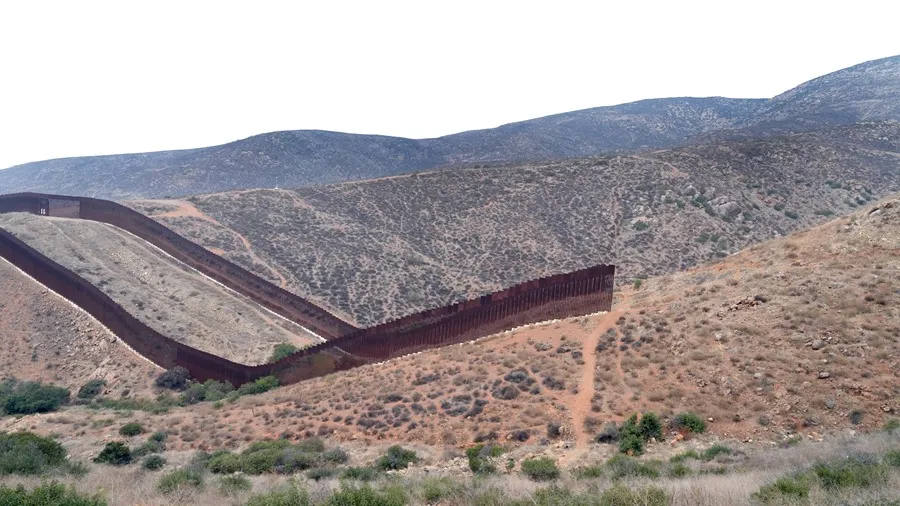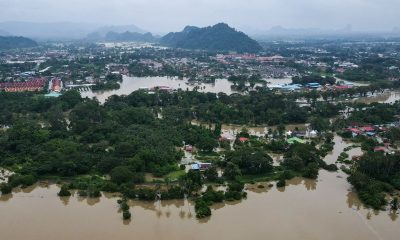International
Even in the Nido de las Águilas, a section without a wall, border crossings in the United States go down

The crossing of asylum-seeking migrants has been reduced in recent weeks on the border of California (USA) with Mexico, even by the popular Nido de las Águilas, a stretch of about 500 meters without a wall and one of the favorites of coyotes or human traffickers in decades.
The Border Patrol recognizes that the area, just 5 kilometers east of the urbanized area of San Diego, where the Otay mountains begin to be steep, is still one of the resources of migrants to enter the country. “There are migrants who still continue to cross in that area, as in others of the San Diego Sector of the Border Patrol,” said officer Gerardo Gutiérrez.
However, the Patrol says it does not know how many people have crossed there since President Donald Trump took office on January 20. Throughout San Diego County, civilian groups and the Coast Guard have reported a total of 77 detainees, but now most, 63, have arrived by sea, and there are no reports of arrests in the area without walls.
Residents of the place told EFE that although they still hear nocturnal noises of people passing by, now it is minimal. “I would tell you that at the end of 2023 large groups of people passed by, from about 30 to 40 people every now and then. One group was on right now and in minutes the other. Now I only have to see a small group of four people and stop counting, that was all, about two weeks ago,” Ventura, a resident of the area in Tijuana (Mexico) told EFE.
“I see that they continue to arrive, but it can no longer be compared,” said another resident of the Nido de las Águilas neighborhood, a highly populated neighborhood in Tijuana where the border wall about 9 meters high is interrupted.
The resident whose window has a direct view of the border said that now “very few people are seen crossing. Nothing as it was until a few months ago.”
Without wanting to say his name or accepting that photos be taken “for safety”, he said that “before they were groups every now and then: last year still sometimes in an hour I could see groups one after another.”
‘El Nido’ became one of the most frequented corridors since the 1990s, when the construction of the wall with Mexico began for the first time on the San Diego border and the Border Patrol deployed for the first time a larger operation, Operation Guardian.
The wall was then a closed metal obstacle ten feet (about 3 meters) high with a sharp finish that often cut fingers or caused injuries to migrants.
But unlike San Diego, with the largest and most populated urban area on the US border, ‘El nido’ has constantly had less surveillance and still has no wall, on top of a hill.
From the homes of the people who live in Mexico you can see the two interrupted parallel walls, and also if there is surveillance of the Border Patrol. For those ‘adventages’, it became known as a neighborhood of coyotes.
However, the mountain and open field area on the side of the United States, represents much less obstacle than, for example, San Ysidro, about 10 kilometers to the west, where there is not only a double wall and greater surveillance of patrol boats, but also teams of military engineers reinforced with barbed wire.
Another of the sections where migrants still arrive is to an area between parallel border walls to the west of the San Ysidro checkpoint, where in previous years thousands of people came to camp in search of asylum.
The director of the American Friends Committee, Pedro Ríos, who has headed a permanent post of assistance to migrants who arrive at that point reports only two groups so far this month: eight people from the Middle East and Africa, and a family of six people from Uzbekistan.
The other resource, more frequented since last January 20, is the sea, which has led the Coast Guard to take charge for the first time of intercepting boats with migrants, a task that CBP previously carried out in the Pacific with the support of the Border Patrol.
The Office of Customs and Border Protection (CBP) reported on Tuesday an 85% reduction in crossings along the southern border with Mexico during the first eleven days of the Trump administration, compared to the same period in 2024.
Since former President Joe Biden (2021-2025) decreed greater restrictions on asylum in June 2024, border crossings have been decreasing.
International
El Chapo’s son Joaquín Guzmán López pleads guilty to U.S. drug trafficking charges

Joaquín Guzmán López, one of the sons of notorious Mexican drug lord Joaquín “El Chapo” Guzmán, pleaded guilty on Monday to drug trafficking charges in a U.S. court, months after his brother Ovidio reached a similar plea agreement, according to local media reports.
The defendant appeared before a federal court in Chicago early Monday afternoon and changed his previous plea in the case, the Chicago Tribune reported. U.S. authorities accuse him of forming, together with his three brothers, the cartel faction known as “Los Chapitos.”
The group is believed to have continued the operations of El Chapo, who has been serving a life sentence in the United States since 2019.
Guzmán López, 39, was arrested after landing in Texas in a small aircraft alongside cartel co-founder Ismael “El Mayo” Zambada.
International
Venezuela authorizes return flights as U.S. continues deportations amid rising tensions

The arrival of U.S. aircraft carrying undocumented Venezuelan migrants continued regularly despite rising tensions between Washington and Caracas over President Donald Trump’s military deployment in the Caribbean.
Trump maintains that the deployment is part of an anti-narcotics operation, while Venezuelan President Nicolás Maduro insists the true objective is to remove him from power and seize the nation’s oil resources.
Venezuela’s aviation authority has “received a request from the United States government to resume repatriation flights for Venezuelan migrants from that country to Venezuela,” the Ministry of Transportation said in a statement .
“Under the instructions of President Nicolás Maduro, authorization has been granted for these aircraft to enter our airspace,” it added.
Caracas will permit two Eastern Airlines flights to land on Wednesday and Friday.
Migration remains one of the Trump administration’s flagship issues. On Monday, the U.S. president held a meeting with his National Security Council to discuss the situation in Venezuela, a day after confirming he had spoken with Maduro by phone, without offering further details.
According to the Venezuelan government, roughly 75 deportation flights have been carried out this year, returning at least 13,956 Venezuelans from the United States.
International
20,000 rounds stolen from german army after driver leaves cargo unattended

The German army confirmed the theft of a shipment of ammunition that occurred a week ago while it was being transported by a civilian delivery driver, a military spokesperson told AFP, confirming earlier media reports.
According to Der Spiegel and the regional broadcaster MDR, around 20,000 rounds of ammunition were stolen from an unguarded parking lot near Magdeburg, in eastern Germany, while the driver was asleep in a nearby hotel. No information has been released regarding the identity of the suspects, and the military declined to specify the exact type or amount of ammunition taken.
Authorities have also not indicated how the perpetrators knew the cargo would be left unattended.
“The theft was discovered upon delivery at the barracks,” the German army spokesperson said.
A police spokeswoman confirmed to AFP that an investigation has been opened but refused to provide further details “for tactical reasons.”
Sources close to the German military, cited by Der Spiegel, believe it is unlikely the theft was a coincidence. They suspect the thieves waited for the driver to stop for the night before striking.
Der Spiegel also reported that the Defense Ministry normally requires two drivers for this type of transport to ensure the cargo is constantly monitored. However, in this case only one driver was assigned, meaning the civilian transport company failed to comply with the security protocols.
-

 Central America4 days ago
Central America4 days agoTrump Pardons Former Honduran President Hernández and Warns of Aid Cuts Ahead of Election
-

 Central America3 days ago
Central America3 days agoHonduras Extends Voting by One Hour Amid High Turnout, CNE Announces
-

 International2 days ago
International2 days agoHong Kong police arrest 13 over deadly high-rise fire that killed 151
-

 Central America3 days ago
Central America3 days agoHonduras’ China–Taiwan Future Hinges on Sunday’s Presidential Election
-

 International4 days ago
International4 days agoMeta Says Russia Seeks to Ban WhatsApp for Defending Secure Communication
-

 International2 days ago
International2 days agoSri Lanka and Indonesia deploy military as deadly asian floods kill over 1,000
-

 International2 days ago
International2 days agoTrump says asylum decision freeze will remain in place “for a long time”
-

 International2 days ago
International2 days agoChile enters runoff campaign with Kast leading and Jara seeking a last-minute comeback
-

 International20 hours ago
International20 hours ago20,000 rounds stolen from german army after driver leaves cargo unattended
-

 International20 hours ago
International20 hours agoVenezuela authorizes return flights as U.S. continues deportations amid rising tensions
-

 International20 hours ago
International20 hours agoEl Chapo’s son Joaquín Guzmán López pleads guilty to U.S. drug trafficking charges
-

 International21 hours ago
International21 hours agoTrump convenes National Security Council as U.S.–Venezuela tensions intensify






























